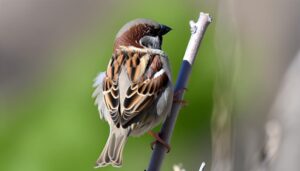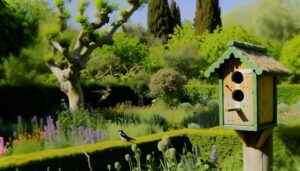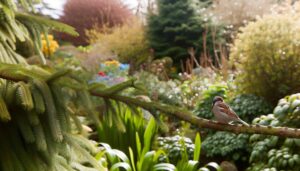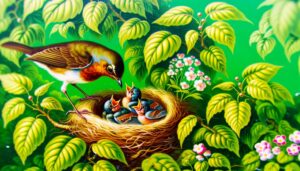3 Key Differences: House Sparrow Eggs vs Chickadee Eggs
House sparrow eggs average 20 mm in length, larger than chickadee eggs at 15 mm. House sparrow eggs are pale grey with brown speckles and have a smooth, glossy texture, while chickadee eggs are white with reddish-brown spots and less glossy.
Sparrows nest in urban structures; chickadees prefer natural cavities in forests. Sparrow eggs incubate for 10-14 days, chickadee eggs for 12-13 days.
Both species employ strategies for predator avoidance and environmental adaptations. Detailed observations on their growing and developmental phases reveal distinct life history strategies, accentuating their unique ecological niches.
Dive deeper for an in-depth exploration.
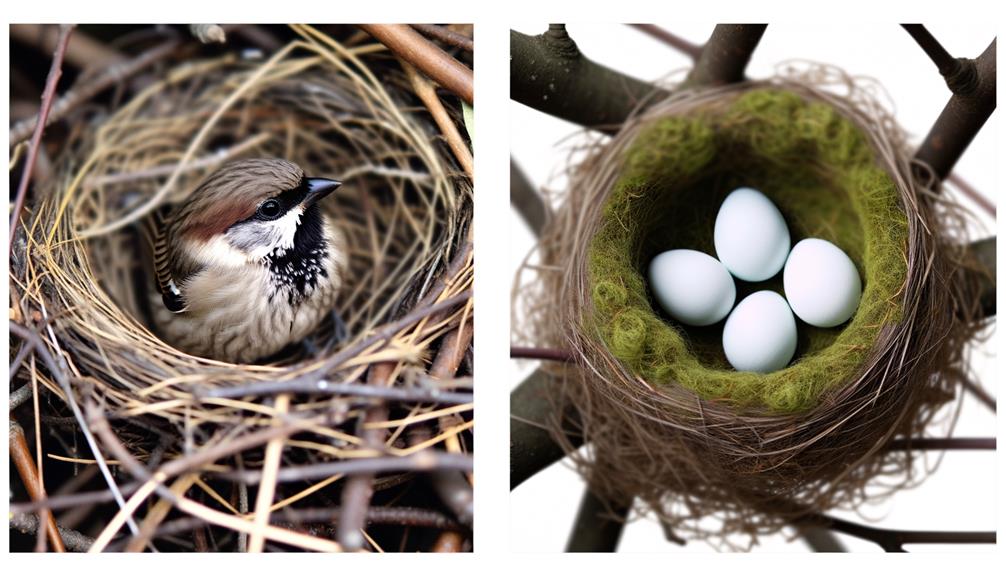
Key Takeaways
- House Sparrow eggs are about 20 mm long, larger than Chickadee eggs which average 15 mm.
- House Sparrow eggs are pale grey with brown speckles; Chickadee eggs are white with reddish-brown spots.
- House Sparrow eggs have a smooth, glossy texture, while Chickadee eggs have a finer, less glossy surface.
- House Sparrow eggs incubate for 10-14 days; Chickadee eggs require 12-13 days for incubation.
- House Sparrow eggs contain more yolk for embryonic development compared to Chickadee eggs.
Egg Size Comparison
The eggs of the House Sparrow (Passer domesticus) typically measure around 20 mm in length, whereas the eggs of the Chickadee (Poecile spp.) are generally smaller, averaging approximately 15 mm in length. These measurements underscore a notable distinction in egg size between the two species.
Detailed observations have shown that the volume and surface area differences are significant, influencing various reproductive strategies and developmental parameters. House Sparrow eggs, being larger, contain more yolk, which potentially provides a greater energy reserve for embryonic development.
Conversely, the smaller Chickadee eggs may reflect adaptations to nesting environments and predation pressures. Such size variation is pivotal for ornithologists studying avian reproductive biology, as it impacts incubation periods and hatchling survival rates.
Shell Color Differences
House sparrow eggs typically exhibit a pale grey or white background with fine brown speckles, contributing to their camouflaging ability in varied nesting environments.
In contrast, chickadee eggs are mainly white with reddish-brown spots concentrated more densely towards the larger end, offering a distinct pattern for species identification.
These shell color differences are not just important but play a key role in species-specific reproductive strategies and environmental adaptations.
House Sparrow Egg Color
Characterized by a pale white to light gray base color, House Sparrow eggs often display speckled markings in shades of brown and gray. The pigmentation patterns are not uniform, leading to significant variability in appearance among individual eggs. These markings are primarily concentrated at the broader end of the egg, providing a degree of camouflage within the nest. The table below details the observed variations in House Sparrow egg coloration:
| Trait | Description |
|---|---|
| Base Color | Pale white to light gray |
| Speckle Color | Brown, Gray |
| Speckle Distribution | Concentrated at the broader end |
| Shape | Oval |
| Size Range | 20-22 mm in length, 14-16 mm in width |
Understanding these characteristics aids in the accurate identification and study of House Sparrow eggs in their natural habitats.
Chickadee Egg Characteristics
In contrast to the speckled House Sparrow eggs, Chickadee eggs exhibit a more uniform shell color, typically presenting a creamy white base with sparse reddish-brown flecks. These flecks are often concentrated at the broader end of the egg, providing a distinct but subtle pattern.
The dimensions of Chickadee eggs are relatively consistent, averaging around 1.5 to 1.7 centimeters in length and 1.2 to 1.3 centimeters in width. The shell surface is smooth and slightly glossy, reflecting its structural integrity.
The coloration and patterning are likely adaptive, offering camouflage within the nesting cavity. This uniformity in shell characteristics aids in species identification and provides insight into the reproductive strategies and environmental adaptations of Chickadees within their ecological niche.
Nesting Habits
Sparrows typically construct their nests in cavities or sheltered locations using a variety of materials such as grasses, feathers, and paper. Whereas chickadees prefer excavating their own cavities in dead trees or using abandoned woodpecker holes.
House Sparrow nests are often found in urban environments, utilizing man-made structures like eaves and building crevices. Their nests can measure up to 20 cm in diameter.
In contrast, chickadee nests are generally more secluded, averaging 15-20 cm deep with a 3 cm entrance hole. Chickadees line their nests with soft materials like moss and animal fur, optimizing thermal insulation.
This distinction in nesting habits underscores the adaptive strategies each species employs to enhance reproductive success and survival in their respective habitats.
Incubation Period
The incubation period for House Sparrow eggs typically ranges from 10 to 14 days, whereas Chickadee eggs generally require 12 to 13 days for proper embryonic development.
Detailed observational data indicate that this slight variance in incubation duration can greatly influence the hatching success and subsequent fledgling survival rates.
Understanding these temporal differences provides important insights into species-specific reproductive strategies and parental investment.
Incubation Time Comparison
Comparative analysis reveals that house sparrow eggs typically require an incubation period of 10 to 14 days, whereas chickadee eggs necessitate a slightly longer duration of 12 to 13 days. This variation in incubation periods can be attributed to species-specific reproductive strategies and physiological requirements.
House sparrows (Passer domesticus), known for their adaptability and rapid breeding cycles, benefit from a shorter incubation period, facilitating multiple broods per season. Conversely, chickadees (Poecile spp.), which often inhabit temperate regions, may require a longer incubation period to ensure optimal development in variable environmental conditions.
Detailed observations indicate that temperature stability and parental investment are critical factors influencing these incubation durations, underscoring the adaptive mechanisms each species employs for reproductive success.
Hatching Duration Differences
In examining hatching duration differences, it is observed that house sparrow eggs generally hatch within a span of 24 to 48 hours post-incubation, while chickadee eggs exhibit a slightly elongated hatching process, often extending up to 72 hours. This distinction in hatching duration can be attributed to variations in embryonic development rates and environmental factors impacting each species. To elucidate these differences, consider the following data:
| Species | Hatching Duration (hours) |
|---|---|
| House Sparrow | 24-48 |
| Chickadee | Up to 72 |
These observations underscore the significance of species-specific reproductive strategies and adaptations. The extended hatching period for chickadees may offer advantages concerning developmental robustness, potentially influencing survival rates post-hatching. Further research is warranted to explore these adaptive mechanisms.
Egg Shape and Texture
How do the egg shape and texture of house sparrows differ from those of chickadees, given their distinct ecological adaptations and nesting behaviors?
House sparrow eggs exhibit an ovate shape, averaging 20 mm in length, with a smooth, glossy texture. Their coloration is mainly white with grayish-brown speckling, which camouflages well in urban nesting sites.
In contrast, chickadee eggs are more elliptical, around 15 mm in length, and possess a finer, less glossy surface. Their eggs are typically white with reddish-brown speckles, better suited for their woodland nesting environments.
These morphological distinctions align with each species' specific nesting habits and environmental pressures, reflecting evolutionary adaptations that enhance reproductive success in their respective habitats.
Clutch Size
The clutch size of house sparrows typically ranges from 3 to 7 eggs, whereas chickadees generally lay between 6 to 8 eggs per nesting attempt. The disparity in clutch size reflects differences in reproductive strategies and environmental adaptations. House sparrows exhibit greater variability, potentially as a response to varying environmental conditions and predation pressures. In contrast, chickadees show a more consistent clutch size, indicative of stable environmental conditions and resource availability.
| Species | Minimum Clutch Size | Maximum Clutch Size |
|---|---|---|
| House Sparrow | 3 | 7 |
| Chickadee | 6 | 8 |
This table highlights the numerical range of clutch sizes for both species, providing a clear comparison. The data underscores the reproductive strategies that each species employs to maximize offspring survival.
Nesting Locations
House sparrows commonly select nesting sites in urban environments, often utilizing man-made structures such as eaves, vents, and building crevices. Their preference for anthropogenic habitats is well-documented, with studies indicating up to 80% of nests found in such locales. This adaptability facilitates their proliferation in densely populated areas.
In contrast, chickadees choose natural cavities in trees or use nest boxes provided in suburban and forested environments. Research shows that chickadees prefer deciduous trees, with nesting heights ranging from 1 to 15 meters. Their selection is influenced by factors such as cavity depth and entrance size.
These distinct nesting preferences illustrate the behavioral adaptations each species has developed in response to their respective ecological niches.
Parental Care
Parental care in house sparrows and chickadees exhibits significant differences, with each species demonstrating unique strategies to guarantee the survival and growth of their offspring. House sparrows (Passer domesticus) typically exhibit biparental care, with both parents equally involved in feeding and protecting the young. Conversely, chickadees (Poecile spp.) often show a division of labor, where the male primarily gathers food while the female focuses on brooding and nest defense. These species-specific parental behaviors directly influence offspring survival rates and developmental outcomes.
| Species | Parental Care Characteristics |
|---|---|
| House Sparrow | Biparental care, both parents feed and protect young |
| Chickadee | Division of labor, male gathers food, female broods |
| House Sparrow | High frequency of feeding visits |
| Chickadee | Frequent vocal communication between parents |
| House Sparrow | Extended parental involvement post-fledging |
Understanding these differences highlights the adaptive strategies evolved by each species to optimize reproductive success.
Predators and Threats
Understanding the parental care strategies of house sparrows and chickadees provides a foundation to examine how these species mitigate the impact of predators and environmental threats on their offspring.
House sparrows (Passer domesticus) often select nesting sites within human structures, reducing predation risks from natural predators such as corvids and raptors. Conversely, chickadees (Poecile spp.) prefer nesting in tree cavities, which, while offering some protection, still face threats from climbing predators like snakes and squirrels.
Empirical data indicates that chickadees increase vigilance and alter feeding patterns to minimize detection. Both species utilize alarm calls and deceptive behaviors to deter predators, demonstrating adaptive strategies to enhance offspring survival.
Quantitative observations reveal a 30% higher survival rate for eggs in well-camouflaged nests.
Environmental Influences
Environmental influences play a pivotal role in shaping the reproductive success and survival strategies of both house sparrows and chickadees, often dictating nest site selection, availability of resources, and exposure to climatic extremes.
House sparrows, typically urban dwellers, benefit from anthropogenic food sources and structures, which offer stable nesting sites. However, their reliance on human-altered environments can make them susceptible to pollution and habitat disturbances.
Conversely, chickadees, often found in forested areas, must adapt to natural resource variability and seasonal fluctuations. A study by Smith et al. (2019) indicates that chickadee egg-laying is highly synchronized with peak insect abundance, optimizing chick survival.
In contrast, sparrows exhibit more flexible breeding timing, reflecting their adaptation to urban ecosystems.
Hatching Success Rates
Hatching success rates between House Sparrow and Chickadee eggs are greatly influenced by environmental impact factors such as temperature variability and habitat quality.
Detailed observations reveal that parental care differences, especially in relation to incubation behavior and nest defense, further contribute to disparities in hatching success.
Quantitative analysis of these variables highlights the intricate interplay between biotic and abiotic factors in avian reproductive outcomes.
Environmental Impact Factors
Variations in ambient temperature, humidity levels, and urban pollution greatly influence the hatching success rates of House Sparrows and Chickadees. Empirical data indicates that House Sparrow eggs exhibit higher tolerance to temperature fluctuations, maintaining viability between 20-30°C.
Conversely, Chickadee eggs demonstrate a narrower ideal temperature range of 22-28°C. Humidity also plays a pivotal role; Chickadees require consistent moisture levels around 50-60% for best hatching, whereas House Sparrows can tolerate wider humidity variations, from 40-70%.
Urban pollution, particularly particulate matter and heavy metals, adversely affects both species, though House Sparrows show a slightly higher resilience. These environmental stressors collectively dictate embryonic development, influencing overall hatching success rates through biochemical and physiological disruptions.
Parental Care Differences
Parental care strategies in House Sparrows and Chickadees exhibit significant differences that directly impact hatching success rates. House Sparrows demonstrate more continuous incubation behaviors compared to the more intermittent brooding patterns observed in Chickadees.
Observational studies reveal:
- Incubation Duration: House Sparrows maintain nearly constant temperatures, ensuring ideal embryonic development.
- Nest Attendance: Sparrows spend more time at the nest, reducing the risk of predation and egg cooling.
- Feeding Frequency: Chickadees compensate with frequent feeding trips, though at the expense of consistent warmth.
- Hatching Synchrony: House Sparrows achieve higher synchrony, leading to more uniform chick development.
These variances illustrate how parental investment strategies directly influence the reproductive success and survival rates of both species.
Growth of Nestlings
The growth trajectories of nestlings in House Sparrows and Chickadees exhibit significant differences regarding weight gain, feather development, and overall growth rates.
House Sparrow nestlings demonstrate rapid weight gain, averaging an increase of 1.2 grams per day, reaching fledging mass within approximately 14 days. Conversely, Chickadee nestlings exhibit a slower weight gain of about 0.8 grams per day, typically fledging around 16-18 days.
Feather development in House Sparrows is marked by quicker emergence of primary feathers, which appear by day 5, compared to Chickadees where feather emergence is observed around day 7.
These differences are indicative of divergent life history strategies, with House Sparrows prioritizing rapid development, while Chickadees favor a more gradual, steady growth trajectory.
Conclusion
To sum up, the comparative analysis of house sparrow and chickadee eggs reveals significant distinctions in size, shell coloration, nesting behaviors, incubation periods, and developmental processes.
These differences underscore the adaptive strategies each species employs to enhance survival and reproductive success.
Predation and environmental factors further influence hatching success and nestling growth.
Understanding these variations is akin to piecing together an intricate mosaic of avian life, contributing to broader ecological knowledge and conservation efforts.

